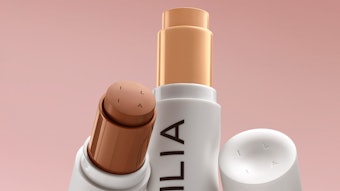- Nail polish has skyrocketed to a greater importance in the beauty industry in recent years (with sales of $1 billion in 2012), and part of that rise in popularity is its universal appeal.
- Many beauty consumers find nail polish to be an affordable luxury, often switching colors and trying new brands. And though they sometimes seek professional nail procedures, DIY is still huge in nails.
- Color seems to be the biggest concern in a consumer’s desire for a certain polish product, as many aren’t yet looking at other ingredients.
- Loyalty isn’t yet a big trend in nail care, as many women own colors from multiple brands and can own more than 30 bottles of nail polish at once.
Walking the exhibit floor at Cosmoprof North America this year, I was struck by the enormity of nail polish offerings. It seemed every other exhibitor had vast racks of colorful, shimmering, glittery bottles on display. Lacquers and mattes, textures, gels… the styles, colors, treatments and tools were endless.
Women cannot get enough of nail polish, evidenced by 2012 U.S. nail polish sales of $768 million, a 32% gain from the previous year. No matter consumers’ age or socioeconomic situation, when it comes to the nail care segment of beauty, nail polish is the great equalizer. Women from all walks of life share very similar outlooks, views, hopes, dreams and wishes from their nail polish brands, and they also share a very similar view of nail polish—it’s fun!
Whether she is looking for her favorite tried-and-true brand or something completely new, these consumers are engaged with their options, and, unlike some other categories in beauty (skin care or fragrance), relatively few women feel over- (or under-) whelmed with the choices available to them, with new brands entering the arena all the time. And this insatiable appetite for nail polish is great news for beauty brands.
To get down to what is really driving the nail polish consumer, in TBC’s 2014 PinkReport “Nailed: The Allure of Nail Color,” we took a deep dive into the key areas of inquiry about today’s nail color consumer. We surveyed more than 3,000 women and unveiled her thoughts on nail polish brands, her nail color behaviors and her nail color motivations. We discovered who is she, why she loves nail color, and how you can make her loyal to your brand and its products.
The Universal Appeal of Nail Polish
So, what makes the nail polish consumer so exciting? Plenty. This consumer is every woman, and also most young girls. She’s the business woman who is happy with her weekly French manicure, and she’s the high school senior obsessed with mimicking every nail design she sees on Pinterest. She’s the mom with four kids and the grad school student, the tomboy and the girly-girl. In short, today’s nail polish consumers transcend boundaries and defy classification because all women enjoy the elements of fun, ease and experimentation that wearing nail polish offers in an affordable way. Here are some key highlights of what TBC learned in its 2014 PinkReport products segment:
Nail polish rules!
- Consumers love their mani/pedis. More than 50% of all nail polish users at every age agree strongly that a great manicure is important, as well as that a new nail polish is a fun pick-me-up.
- Younger women are more likely to feel “off” if their nails aren’t polished, and they admit that buying a new nail polish makes them feel excited and happy.
- Only a minimal percentage of consumers agree overall that they purchase the same color of nail polish over and over. In other words, bring on the selection, baby. She wants more options.
- The younger she is, the more she enjoys shopping for new nail polish. Sixty percent of 16–19-year-olds strongly agree this activity is fun versus just 36% of 55–69-year-olds. But don’t be fooled—all women enjoy shopping for nail products to some degree.
- Although she believes a manicure is the final detail to a great outfit, only a little more than a third of all consumers strongly agree that a manicure is a worthwhile expense, indicating that affordability and price are still key considerations across the board.
- Unless it’s a special color or she can’t find the shade any longer, she probably won’t go to the trouble of trying to save her old polishes when they start to dry out; she’d rather just go and buy a new one.
Budgetary concerns and nail polish
- Women aged 30–39 are most likely to agree strongly that they never worry about the money they spend on their manicures and pedicures. However, this percentage is small (15% and 17%, respectively). Cost and expense will continue to be key in engaging this consumer, particularly in the salon.
- Who feels most guilty about buying new nail polish when she still has unfinished bottles hanging around? Sixteen to 24-year-olds were statistically more likely to strongly agree they feel guilty for doing this than any other age bracket.
- This age group also is more likely to have a budget in mind when shopping for new nail polish. They also are more likely to believe expensive nail polish might not be the best investment: 26% of consumers aged 16–19 believe strongly expensive nail polish is a waste of money versus just 8% of 40–49-year-olds.
All nail products, all the time
- The majority of nail polish consumers own more than thirty bottles of nail polish.
- Even with a well-established presence in the nail polish landscape and a host of up-and-coming new brands, she still identifies OPI (72%) and Essie (40%) as “hot” brands. Other hot brands on her radar (even though she’s not using them) include: Butter London (24%); China Glaze (23%); Sephora by OPI (22%); and Zoya (21%).
The love of color
- From classics to contemporaries, she likes her color. Classics are keepers. If she could only wear one nail polish color for the rest of her life, pink is far and away the preferred color (41%), followed by red (19%) and purple (9%).
- She also identifies herself as more of a classicist. Seventy-three percent indicate they would choose to wear traditional colors (pink, red, beige) versus modern shades of blue, green or yellow. However, this split skews sharply by age. As expected, younger consumers are much more likely to choose the blue and green polish colors over the mature consumer, who prefers her light beige and soft pink hues.
Nailed: Her Behaviors
For this highly connected and engaged beauty consumer, her beauty behaviors are central to her daily routine and lifestyle. She enjoys the benefit that using makeup and beauty products brings to her life, and her daily choices reflect this commitment. Not one to shy away from trying something new, she’s also not one to be swayed to a new product simply because it’s the latest fad. Instead, she wants her nail products to work reliably, be fun, safe and affordable, and to give her options.
To find their favorite nail colors and brands, women are browsing the nail aisle at three main retail outlets: drugstores (CVS, Walgreens); superstores (Walmart), and beauty specialty stores (Sephora, Ulta). And when it comes to her manicure, women are still very much in the DIY camp. Fifty-six percent typically polish their fingernails at home while only 7% typically go to a salon.
In fact, the highest percentage of women (25%) report they get a professional, in-salon manicure only for special occasions, with just 12% going monthly for a manicure refresh. And forget expensive professional manicures as a regular thing. The majority of women (80%) won’t pay over $50 for a professional nail polish experience.
Here are some key highlights of what TBC learned in the behaviors segment:
Give Her Choices
- Only 22% of nail polish consumers want their nail polish and toenail polish to always match. The vast majority (60%) only wants them to sometimes match, and 13% don’t want them to match at all.
- Both more traditional nail polish finishes (cream, pearl) as well as more modern finishes (glitter, matte, textured) are appealing to consumers. Twenty to 34-year-olds are more likely to prefer a gloss finish, while shimmery shades speak to 16–24-year-olds.
- Even if she’s got a backlog of unfinished bottles of nail color in her medicine chest, she’s not likely to finish a full bottle of color—and she’s OK with that. Forty-seven percent say they sometimes use up an entire bottle of nail polish—and only if the color is amazing—while 41% say they never use up all of the polish.
Chemicals are a concern, but not a dealbreaker
- She’s concerned about the ingredients in her nail polish, but not detrimentally so. Less than half of all consumers (45%) are concerned about harmful toxins in their products, and 36% have never thought about it.
- She’s not seeking out “safe” nail products—yet. Fifty-six percent are not seeking out toxin-free polishes; however, 30% do purposefully purchase non-toxic nail products, as awareness is growing.
- Natural and organic is not a key driver for nail polish purchase or usage, and only 12% of consumers strongly agree they look for nail and foot care products that are natural or organic.
Her loyalty isn’t absolute, even if she loves you
- Ninety-two percent of nail polish consumers agree toenail polish lasts longer than fingernail polish, however; she’s far more likely to change her fingernail color on a weekly basis.
- Fortunately, she’s excited to have a lot of nail color options and choices. Unfortunately, that means she’s also not very loyal, and on average, half of all consumers aged 16–54 agree strongly that they like to try new nail polish brands.
- However, this doesn’t mean she thinks all brands are the same. Only 6% or less of all consumers agree strongly that one nail polish brand is just about the same as another.
I know what I like, but I’m not sure I want to be the artist
- She may love to try new colors and will be quite all right with having multiple unfinished bottles of color lying about, but the older she gets, the less interested she is in trying to create her own “custom” color. Seventy-five percent of women aged 35–49 have never mixed two colors together to create a new shade.
- Younger nail polish consumers are more likely to experiment with color. Forty-three percent of 16–19-year-olds will go ahead and turn their nail polish ritual into a chance to pretend they are Van Gogh by mixing shades together.
Where she’s shopping
- Keep it accessible. She’s seeking out her next favorite nail color or product at Walmart, Target, Sephora or Ulta.
- Although younger consumers are more likely to turn to the Internet to purchase nail products and colors, online channels are just not yet a major purchasing pathway for this consumer.
The Full Report
The full 2014 PinkReport dives into a sea of detail about her usage and buying habits, as well as trends she’s following, and it uncovers which particular brands she loves most and why. Complete data tables and top 10 insight sections also are included. You can visit benchmarkingcompany.com/pink-reports/ for more information on TBC’s 2014 PinkReport “Nailed: The Allure of Nail Color,” and look for an all-new 2015 PinkReport early next year.
Denise Herich is co-founder and managing partner at The Benchmarking Company, a bi-coastal consumer research firm borne from Alisa Beyer’s The Beauty Company. The Benchmarking Company provides marketing and strategy professionals in the beauty and personal care industries with forward-thinking, need-to-know information about its customers and prospects through consumer research studies and beauty product testing.










